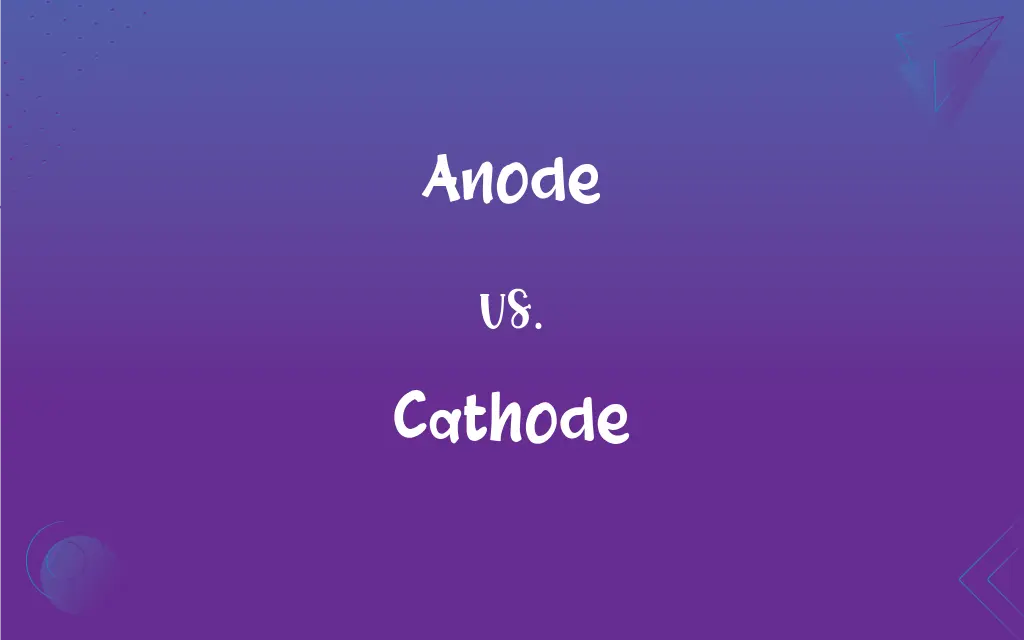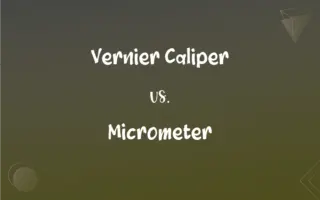Anode vs. Cathode: What's the Difference?
Edited by Aimie Carlson || By Harlon Moss || Updated on October 3, 2023
Anode is the electrode where oxidation occurs; Cathode is where reduction occurs.

Key Differences
Anode and Cathode are terms that describe two different electrodes in an electrical device or reaction. The Anode is conventionally the electrode where oxidation, or the loss of electrons, takes place. In contrast, the Cathode is where reduction, or the gain of electrons, occurs.
In a battery, the Anode is typically the negative terminal, while the Cathode is the positive terminal. However, it's crucial to understand that these designations can reverse based on the operation mode. For instance, during the charging of a rechargeable battery, the Anode becomes the site of reduction, while the Cathode becomes the site of oxidation.
In electroplating, the Anode usually contains the metal that will be plated onto the object, while the Cathode is the object itself. As current flows through the circuit, metal ions from the Anode migrate to the Cathode, depositing a layer on it.
It's worth noting that while many people use Anode and Cathode interchangeably with positive and negative terminals, respectively, it's not always accurate. Their roles are defined by the type of reaction (oxidation or reduction) that happens at each electrode.
Comparison Chart
Reaction
Oxidation
Reduction
ADVERTISEMENT
In Primary Battery
Negative Terminal
Positive Terminal
During Charging of Rechargeable Battery
Positive Terminal
Negative Terminal
In Electrolysis
Where anions travel
Where cations travel
Electroplating
Source of metal ions
Object to be plated
Anode and Cathode Definitions
Anode
In electroplating, the source of metal ions.
The gold Anode slowly dissolves, depositing gold onto the object.
ADVERTISEMENT
Cathode
Electrode that accepts electrons in a device.
Electrons flow into the Cathode of a light-emitting diode (LED) making it glow.
Anode
Electrode where anions move in electrolysis.
Chloride ions migrate towards the Anode during salt electrolysis.
Cathode
Electrode where cations move in electrolysis.
Sodium ions migrate towards the Cathode during salt electrolysis.
Anode
Typically the negative terminal in a primary battery.
Connect the black wire to the Anode of the battery.
Cathode
In electroplating, the object being plated.
The ring acted as the Cathode and got coated with silver.
Anode
Electrode that releases electrons in a device.
Electrons flow out of the Anode in a diode when it's forward-biased.
Cathode
Electrode where reduction occurs.
In a battery, the Cathode is where the chemical reduction takes place.
Anode
Electrode where oxidation occurs.
In a galvanic cell, zinc undergoes oxidation at the Anode.
Cathode
Typically the positive terminal in a primary battery.
Connect the red wire to the Cathode of the battery.
Anode
A positively charged electrode, as of an electrolytic cell, storage battery, diode, or electron tube.
Cathode
A negatively charged electrode, as of an electrolytic cell, storage battery, diode, or electron tube.
Anode
The negatively charged terminal of a primary cell or of a storage battery that is supplying current.
Cathode
The positively charged terminal of a primary cell or a storage battery that is supplying current.
Anode
(electricity) An electrode, of a cell or other electrically polarized device, through which a positive current of electricity flows inwards (and thus, electrons flow outwards). It can have either a negative or a positive voltage.
Cathode
(electricity) An electrode, of a cell or other electrically polarized device, through which a positive current of electricity flows outwards (and thus, electrons flow inwards). It usually, but not always, has a positive voltage.
Anode
The electrode at which chemical oxidation of anions takes place, usually resulting in the erosion of metal from the electrode.
Cathode
The electrode at which chemical reduction of cations takes place, usually resulting in the deposition of metal onto the electrode.
FAQs
In a primary battery, which is the negative terminal, Anode or Cathode?
Anode is typically the negative terminal.
What is an Anode?
Anode is the electrode where oxidation occurs.
In a primary battery, which is the positive terminal, Anode or Cathode?
Cathode is typically the positive terminal.
In a diode, from which electrode do electrons flow out, Anode or Cathode?
Electrons flow out of the Anode.
Is the Anode always the source of positive ions in electrolysis?
No, Anode is where anions migrate, and it undergoes oxidation.
Is the Cathode always where positive ions migrate in electrolysis?
Yes, Cathode is where cations migrate, and it undergoes reduction.
During the charging of a rechargeable battery, which becomes the site of reduction, Anode or Cathode?
Anode becomes the site of reduction.
In electroplating, which electrode is typically the source of metal ions, Anode or Cathode?
Anode is the source of metal ions.
Which electrode undergoes oxidation, Anode or Cathode?
Anode undergoes oxidation.
Which electrode undergoes reduction, Anode or Cathode?
Cathode undergoes reduction.
During the charging of a rechargeable battery, which becomes the site of oxidation, Anode or Cathode?
Cathode becomes the site of oxidation.
Which electrode releases electrons in a device, Anode or Cathode?
Anode releases electrons.
Which electrode accepts electrons in a device, Anode or Cathode?
Cathode accepts electrons.
Are Anode and Cathode designations constant across all devices?
No, their roles can vary depending on the device and its operation mode.
Do Anode and Cathode always correspond to negative and positive terminals respectively?
No, their roles can reverse based on the operation mode, like during charging of a rechargeable battery.
In a diode, to which electrode do electrons flow in, Anode or Cathode?
Electrons flow into the Cathode.
In electrolysis, where do cations migrate, Anode or Cathode?
Cations migrate towards the Cathode.
What is a Cathode?
Cathode is the electrode where reduction takes place.
In electroplating, which electrode is the object being plated, Anode or Cathode?
Cathode is the object being plated.
In electrolysis, where do anions migrate, Anode or Cathode?
Anions migrate towards the Anode.
About Author
Written by
Harlon MossHarlon is a seasoned quality moderator and accomplished content writer for Difference Wiki. An alumnus of the prestigious University of California, he earned his degree in Computer Science. Leveraging his academic background, Harlon brings a meticulous and informed perspective to his work, ensuring content accuracy and excellence.
Edited by
Aimie CarlsonAimie Carlson, holding a master's degree in English literature, is a fervent English language enthusiast. She lends her writing talents to Difference Wiki, a prominent website that specializes in comparisons, offering readers insightful analyses that both captivate and inform.































































